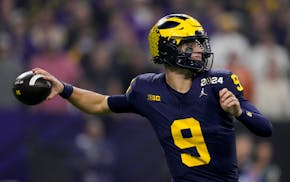Pittsburgh – When golf author and teacher Harvey Penick encountered people bragging about the inability of golfers to break par at their home course, he wouldn't offer congratulations. He'd ask what was wrong with the place.
This week the U.S. Open is being staged at Oakmont Country Club. It is typical of U.S. Open venues in that its beauty is surpassed by its beastliness.
Oakmont begins with a 482-yard par-4 with a fairway almost as wide as a cart path, highlighting a particularly difficult three-hole introduction to what Jordan Spieth has called "the hardest test in golf."
Graeme McDowell called Oakmont "scary" after playing a practice round this week.
There is a 667-yard par-5, the Church Pew bunkers and unnamed ditches. There are turtleback greens that turtles might slip right off. There is punitive greenside bunkering, and par-5 layouts that make saving par a higher priority than gunning for eagle.
The par-3 8th can play at 300 yards. The last time Oakmont played host to a U.S. Open in 2007, Paul Goydos congratulated the USGA for being able to hold long-drive and hole-in-one contests on the same hole.
This week, Oakmont and the USGA seem intent on protecting par. The question is, why?
Golf sets itself apart from other major sports with its honor code. Too often, it sets itself apart from other major sports with backward thinking.
Every other sport tweaks its rules to encourage competitiveness and scoring. Only golf would invite the greatest players in the world to a national championship competition, then try to make them all look bad.
This isn't as prevalent a problem as it once was. The USGA has executed some brilliant course setups in recent decades, highlighting risk-reward decisions instead of hack-it-from-the-rough acts of desperation.
Oakmont signals a return to the bad old days, when one of the world's best players could hit a shot a few feet off the fairway and be unable to advance the ball — if it could be found at all.
"If it played like yesterday with the 15-mile-an-hour wind, it's going to be significantly over par," Spieth said on Monday of the winning score. "If it rains, you can shoot under par. I don't think anybody is going to be in the red come 72 holes."
The golf world might be in luck. Rain is in the forecast for most of Thursday, and Friday morning. Rain might soften the fairways and greens enough to hold slightly errant shots, and might slow the pace of putts.
In other words, it might take an act of God to make the course playable, or remotely enjoyable.
"We are the most sadistic folks you'll ever find; we're gluttons for punishment; we like hard, difficult stuff in Pittsburgh," Chick Wagner, a three-time Oakmont Country Club champion, told ESPN. "We're not a steel town anymore, but we still have that steeler mentality."
That sounds admirable and understandably provincial, but working in a steel factory isn't a spectator sport, and if the Pittsburgh Steelers couldn't find the ball after an incomplete pass, the NFL would be about as popular as jai alai.
Golf organizations shouldn't be insulted by eagles, and golfers shouldn't be discouraged from trying to make them.
In 2007, Angel Cabrera won with a score of 5 over par. He made zero eagles and 13 birdies in 72 holes. He won not because he necessarily hit remarkable shots but because he didn't hit terrible shots. He made zero double bogeys. He won with an aversion to risk, which sounds like a good pitch for a financial institution and a terrible draw for a sport that is always trying to woo casual sports fans.
"Golf courses are either fun, or great, or hard," Phil Mickelson said. "There's nothing fun about Oakmont. There's nothing great about Oakmont. But it's extremely hard. It's probably the hardest course I've ever played."
Purists argue that Oakmont provides the toughest test in golf and therefore identifies the most worthy and well-rounded champion.
That sounds noble, but since 2005 the U.S. Open has produced champions named Michael Campbell, Geoff Ogilvy, Lucas Glover, Webb Simpson and Martin Kaymer.
Too often, the U.S. Open rewards caution rather than talent and risk-taking. As Penick might have asked, what's wrong with eagles?
Jim Souhan's podcast can be heard at MalePatternPodcasts.com. On Twitter: @SouhanStrib. jsouhan@startribune.com

Souhan: These seven plays showcase Wolves' new defensive fire

Souhan: Wolves fans made Game 1 special. Now bring on Game 2.

Souhan: Should Vikings even consider McCarthy in NFL draft?

Souhan: NAW erases Suns' lead, Game 1 advantage with big performance


